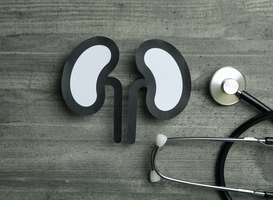In 1959, the first kidney transplant was performed on a child and today around 1,300 children worldwide receive a new kidney every year. It has become a successful treatment when the kidneys stop functioning properly and severe kidney failure occurs. Transplanted kidneys work better today than they did in the early days, when only 42% of the kidneys were still functioning after five years. Now 93% of patients still have a well-functioning donor kidney after five years. Their quality of life has also significantly improved.
The fact that things are going so much better is partly due to better drugs that suppress the immune system. If patients do not take the drugs, the immune system attacks the new kidney, causing it to reject. “Today we have much better drugs at our disposal than in the past. This is the main reason for the better survival of the donor kidney,” says Loes Oomen. She is a medical researcher in the Radboudumc urology department. She and colleagues conducted a large study on the development of kidney transplants in children.
This research, published in Frontiers in Pediatrics, shows that the donor type has changed. Most children who receive a new kidney, especially in the Netherlands, get it from a living donor. Often from a parent. “This has several advantages; the parents are often young and healthy, the surgery can be planned in advance and there is usually a good genetic match,” Oomen said. “A good genetic match reduces the chance of rejection.”
Radboudumc specializes in kidney transplants in children
Radboudumc Amalia Children’s Hospital is one of three Dutch centers where kidney transplants are performed in children. Since 1968, more than 400 children have received a new kidney here. The developments are comparable to those in the rest of the world. In the Netherlands, only in Radboudumc do doctors perform kidney transplants on children under the age of three. With them, however, the donor kidney is placed in the abdominal cavity, because there is not enough space in the pelvis.
Preventing retransplantation
Are we where we need to be? Oomen: “We are pleased with the developments. Important progress has also been made in the multidisciplinary care surrounding an operation. But we want to further improve the care for these patients. A major challenge is adherence to therapy: we note that especially the children in teens don’t always take medicine. ” Rejection may occur. A new transplant is an option, but research shows it’s better to prevent it – retransplanting generally produces worse outcomes for patients.
To prevent dialysis or not?
How do we find the right donor and how do we determine the right time for a transplant? Are you waiting for the most suitable donor with the risk of dialysis or not? Oomen would like an answer to these questions. “Our knowledge of a DNA match helps us with that. And we also know that the donor’s age has an influence.”
Nijmegen’s research previously showed that the bladder of babies with a new kidney doesn’t always function properly. There is also another challenge there. New developments, such as the use of artificial intelligence, merging patient data (as in the European context in the European Health Data Space) or the development of renal organoids for drug research are interesting methods for further research. Watch a Kidney Foundation video on the development of kidney organoids in Radboudumc here.
Edited by: National Care Guide
–


